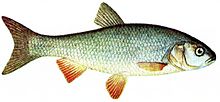This article needs additional citations for verification .(August 2015) |
| Leuciscus | |
|---|---|
 | |
| Ide, Leuciscus idus | |
| Scientific classification | |
| Domain: | Eukaryota |
| Kingdom: | Animalia |
| Phylum: | Chordata |
| Class: | Actinopterygii |
| Order: | Cypriniformes |
| Family: | Leuciscidae |
| Subfamily: | Leuciscinae |
| Genus: | Leuciscus Cuvier, 1816 [1] |
| Type species | |
| Cyprinus leusciscus | |
| Species | |
See text | |
| Synonyms [1] | |
| |
Leuciscus is a genus of fish belonging to the family Cyprinidae. They are inland water fishes commonly called Eurasian daces. The genus is widespread from Europe to Siberia. Species broadly distributed in Europe include the common dace Leuciscus leuciscus and the ide L. idus.
The European chubs were formerly also included in Leuciscus, but they are now usually separated in another genus, Squalius (e.g. the chub, Squalius cephalus). The delimitation of Leuciscus and Squalius is not completely resolved; some species have been moved from one genus to the other only in recent years. The genera Petroleuciscus and Telestes have also been split off from Leuciscus recently; for the latter the same holds true as for Squalius regarding the unclear delimitations.